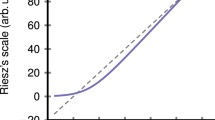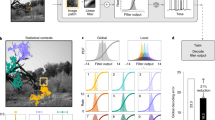Abstract
The attributes of the afferent flow of the cat analyzer under heat, cold, tactile, and pain stimulation are studied. It is shown the flows formed can be described by an attribute vector. It is found that unoccupied regions exist in the vector space of the descriptions of physiologically permissible codes, i.e., there is an excess of code space that could serve for the synthesis of additional channels, including those not inherent in human modalities. In many problems of engineering and medicine, this could be the only way to restore or compensate for lost functions of analyzing systems, such as vision and hearing.
Similar content being viewed by others
References
K. Tsugutika, “The merging of bioengineering and electronics,” Bio Industry (Japan),3, No. 8, 670 (1986).
K. Hiwatashi, “Sensations and sensors from the point of view of bionics,” Oe Butsuri (Japan),54, No. 4, 314 (1985).
R. Taylor, “New directions in biosensor (biochip) development,” Proc. World Biotechnol. Conf., San Francisco, Vol. 2, Part 5, New York (1986), p. 7.
V. A. Antonets, A. V. Zeveke, and G. I. Malysheva, “The possibility of synthesis of an additional sensory channel in a human-machine system,” Sensor. Sist.,6, No. 4, 100 (1986).
A. V. Zeveke and E. D. Efes, “Afferent-impulse response of skin receptors to air flow,” Byull. Éksp. Biol. Med., No. 9, 1030 (1976).
A. V. Zeveke and G. I. Malysheva, “Study of impulse flows from skin receptors under cooling,” Neirofiziologiya,12, No. 4, 413 (1980).
G. I. Malysheva and A. V. Zeveke, “Some characteristics of afferent flow with injurious actions on the skin,” Neirofiziologiya,8, No. 2, 168 (1976).
G. I. Malysheva and A. V. Zeveke, “The structure of afferent flow under painful and nonpainful stimulation of cat skin,” Neirofiziologiya,8, No. 4, 392 (1976).
Additional information
Nizhny Novgorod Medical Institute. Translated from Izvestiya Vysshikh Uchebnykh Zavedenii, Radiofizika, Vol. 37, No. 9, pp. 1156–1161, September, 1994.
Rights and permissions
About this article
Cite this article
Antonets, V.A., Zeveke, A.V., Malysheva, G.I. et al. Study of sensory-code space to assess the possibility of synthesis of additional sensory channels in a human-machine system. Radiophys Quantum Electron 37, 746–748 (1994). https://doi.org/10.1007/BF01039614
Received:
Issue Date:
DOI: https://doi.org/10.1007/BF01039614




